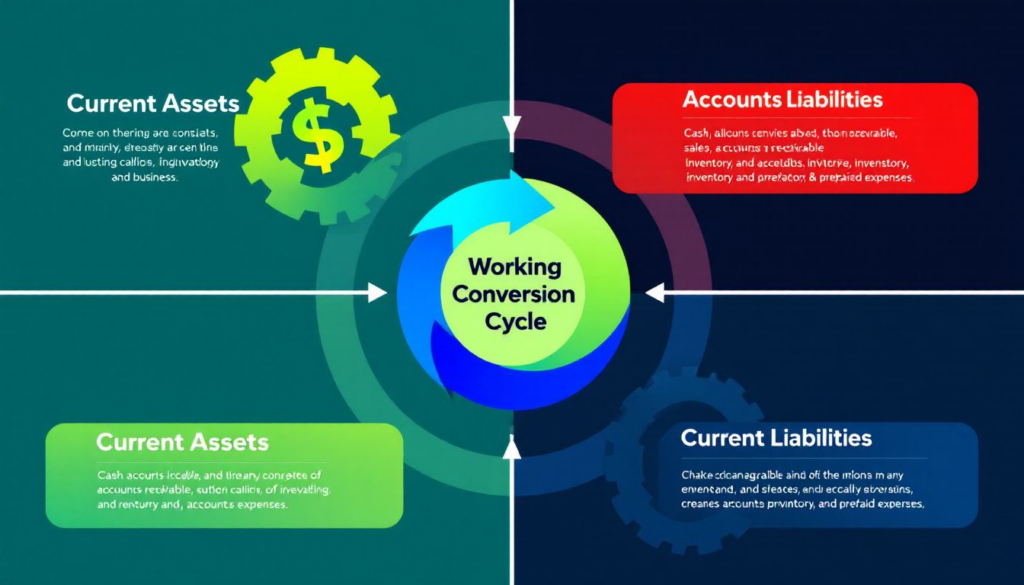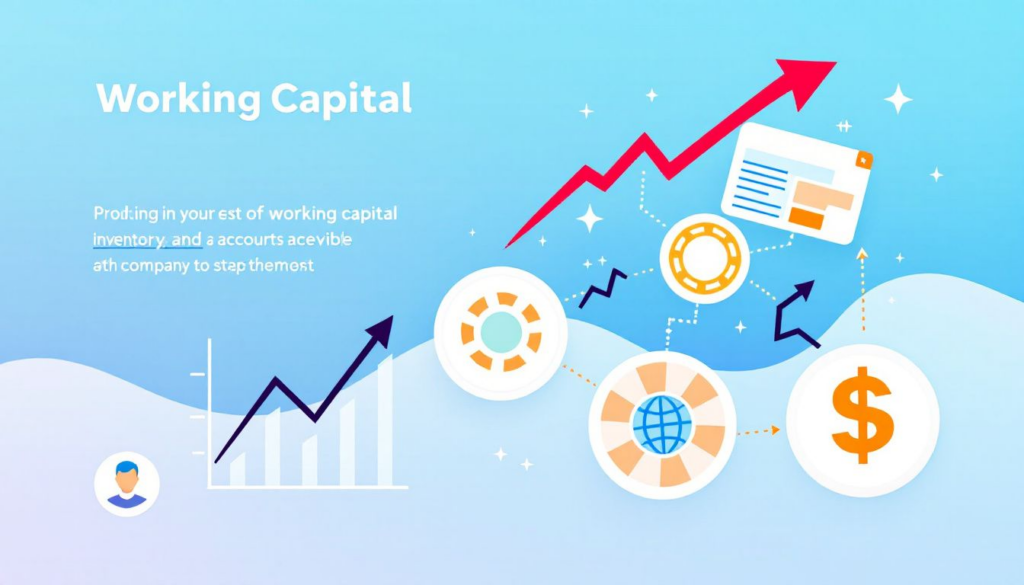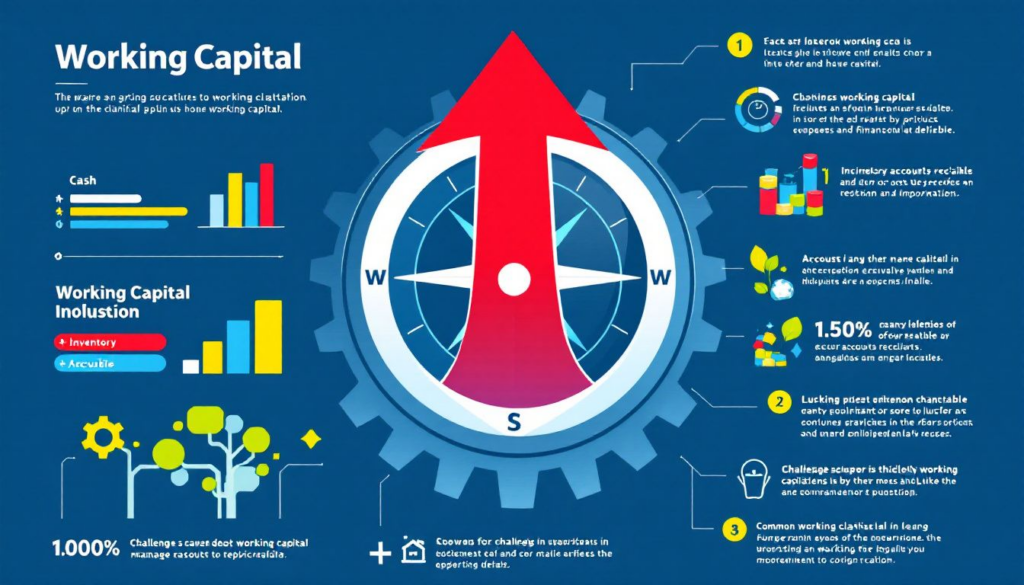Working Capital for Your Business
Do you need to find working capital for your business? This guide reveals practical ways to secure and find working capital via invoice financing. Discover top strategies to keep your operations running smoothly and fund your growth.
Key Takeaways
- Net working capital, defined as the difference between current assets and current liabilities, is crucial for maintaining a company’s liquidity and operational efficiency.
- Managing balance sheet accounts such as accounts receivable, accounts payable, and inventory is essential for optimizing working capital.
- Businesses can improve working capital management by leveraging technology, negotiating better payment terms, and employing strategies like just-in-time inventory and speeding up collections.
- Invoice factoring adds permanent working capital to your business via an A/R-based working capital line.
Understanding Working Capital

Working capital is the lifeblood of any business, defined as the difference between current assets and current liabilities. It represents a company’s short-term liquidity and its capability to cover day-to-day operational expenses. Efficient working capital management ensures the business can meet its financial obligations on time, maintaining smooth operations and facilitating continued investment in growth opportunities.
Effective working capital management enhances a company’s financial health and liquidity, ensuring sufficient cash flow to cover short-term liabilities. Poor working capital management can lead to operational difficulties, such as an inability to pay suppliers, severely hindering business growth. Therefore, understanding and optimizing your working capital is crucial for sustainable operations.
When a company has positive working capital, it has enough liquid assets to meet its short-term liabilities, which is a sign of the company’s financial health and operational efficiency. On the other hand, inadequate working capital can put a business at risk, potentially leading to financial trouble if short-term obligations cannot be met, ultimately affecting the company’s working capital position and net working capital.
Effective working capital management improves overall financial health and maintains the liquidity necessary for successful operations. Turned down for a business loan? Bankers Factoring can help with invoice financing.
Calculating Your Working Capital Needs

Calculating working capital needs is the first step toward effective financial management. The basic formula is current assets minus current liabilities. Current assets include cash, accounts receivable, and sellable inventory, while current liabilities encompass accounts payable, accrued payroll, accrued taxes, short-term debt, and accrued expenses. This formula provides a snapshot of a company’s short-term financial health and ability to cover immediate obligations.
Determining specific working capital requirements involves considering unique business aspects, such as the cash conversion cycle, which measures the time it takes to convert inventory and receivables into cash. The formula Inventory + Accounts Receivable – Accounts Payable can be used to calculate these requirements more precisely.
Understanding these figures aids in planning and ensuring sufficient cash resources are available to meet operational needs and unexpected expenses, supporting efficient working capital management.
Please read how much working capital do you need with our working capital formula.
Key Components of Working Capital
Key components of working capital include accounts receivable, accounts payable, and inventory management, each playing a crucial role in a small business’s financial health.
Accounts receivable represent the amounts owed to the company by customers for goods or services delivered but not yet paid for. Managing accounts receivable involves timely payment collection, setting credit policies, and conducting regular follow-ups on overdue accounts. This ensures a steady inflow of cash and maintains liquidity.
On the other hand, accounts payable are the amounts a company owes to its suppliers and creditors. Managing accounts payables effectively includes negotiating favorable payment terms, ensuring timely payments, and maintaining good supplier relationships. This can help improve cash flow and reduce financial strain on the business.
Inventory management is another vital component, ensuring enough stock to meet customer demand without overstocking. Efficient inventory management prevents excess working capital from being tied up in inventory while ensuring prompt order fulfillment. Techniques like just-in-time (JIT) inventory management and data analytics for demand forecasting can significantly enhance inventory management practices.
Sources of Working Capital
Businesses can tap into various sources of working capital to maintain liquidity and operational efficiency. These include traditional loans, invoice factoring, and business credit cards, each offering unique advantages and potential drawbacks. Selecting the right source depends on the specific financial needs and circumstances of the business.
Working capital loans provide rapid access to funds, helping small businesses overcome short-term financial challenges. Invoice factoring converts unpaid invoices into immediate cash flow, bridging gaps without adding debt.
Business credit cards provide quick access to working capital and often include rewards and extended payment terms, enhancing cash flow management.
Traditional Loans
Traditional loans reliably provide working capital for businesses facing immediate cash flow gaps. These loans cover short-term expenses like payroll and inventory, providing necessary liquidity to maintain operations. However, they often come with higher interest rates due to the elevated risk for lenders, which can complicate cash flow management.
The application process for traditional loans typically requires financial records such as bank statements, tax returns, and a strategic business plan. Repayment terms range from one to two years, offering flexibility to businesses.
Despite potential drawbacks, traditional loans are valuable for managing short-term financial obligations effectively.
Invoice Factoring
Invoice factoring bridges cash flow gaps by selling unpaid invoices to a factoring company for immediate cash advances. This provides immediate liquidity without additional debt, making it a less risky financing option. Businesses can receive a cash advance of 80-93% of the invoice amount, which can be used to cover essential operational expenses.
Invoice factoring allows businesses to convert outstanding invoices into quick working capital, improving cash flow management. Non-recourse factoring, offered by companies like Bankers Factoring, provides bad debt protection by absorbing losses if a customer fails to pay due to credit issues. This ensures businesses can maintain financial stability even if a customer becomes insolvent.
Business Credit Cards
Business credit cards provide quick access to working capital, which is essential for dealing with unexpected costs and boosting operational efficiency. They offer rewards and extended payment terms, enhancing cash flow management and leading to significant savings for small business owners. For example, a cash back corporate credit card can save a business approximately $15,000 annually on $1 million of expenses.
Effective use of business credit cards involves taking advantage of rewards programs and managing expenses to avoid high-interest charges. Cards like the Brex business credit card offer competitive rewards such as points on travel and rideshare, which can further benefit the business.
Using these tools strategically improves working capital management and maintains financial health.
Strategies to Improve Working Capital Management

Improving working capital management involves strategies that enhance financial agility and operational efficiency. Techniques like leveraging automation technology, optimizing inventory management, and negotiating better payment terms with suppliers can significantly improve financial performance. These strategies ensure sufficient cash flow and better preparation for financial challenges.
Continuous improvement in working capital management is crucial for sustaining growth and stability. Adopting best practices and staying proactive can optimize the cash conversion cycle and enhance overall financial health.
Please read the 6 causes of cash flow problems.
Optimizing Inventory Management
Effective inventory management maintains optimal stock levels without overstocking or understocking. Techniques like just-in-time (JIT) inventory management can significantly reduce capital tied up in inventory while ensuring customer demand is met. Utilizing data analytics helps businesses predict demand more accurately, leading to better inventory management decisions.
Case studies like ABC Retail Chain and XYZ Manufacturing show how centralized inventory systems and JIT practices can improve inventory turnover and reduce carrying costs. These examples highlight the importance of effective inventory management in improving working capital management and operational efficiency.
Speeding Up Receivables Collection
Speeding up receivables collection is crucial for maintaining healthy cash flow. Offering early payment discounts, like a 2% discount for payments within 10 days, can incentivize customers to pay faster. Implementing reminders and following up on overdue invoices can drive timely collections. Automating invoicing processes reduces payment collection time and improves overall cash flow management.
Managing receivables effectively involves establishing clear credit policies and improving collection practices to avoid potential cash flow issues. Accelerating customer payments enhances working capital availability and maintains financial stability.
Negotiating Better Payment Terms
Negotiating better payment terms with suppliers can significantly improve cash flow. Extending payment terms from 30 to 45 or 60 days allows businesses to preserve cash flow and manage financial obligations more effectively. This strategy is particularly beneficial for businesses with tight cash flow cycles.
Additionally, businesses can offer commitments to higher purchase volumes or faster payment on part of the invoice in exchange for more favorable terms. Streamlining accounts payable processes and fostering better supplier relationships further enhance working capital management and operational efficiency.
Leveraging Technology for Working Capital Management

Leveraging technology transforms working capital management by enhancing operational efficiency and streamlining cash flow processes. Tools like Kyriba provide real-time cash visibility and aid in liquidity management, while Brex offers innovative financial tools to improve cash flow strategies. Automated financial tools facilitate tracking key working capital metrics and support informed decision-making.
Cash flow forecasting is a critical technology-driven strategy that allows businesses to anticipate cash shortfalls or surpluses, guiding working capital decisions. Real-time expense tracking and automated spend management software provide quicker insights into financial performance, enabling more efficient working capital management and a better understanding of cash flows.
How Much Working Capital Do You Need?
Determining the right amount of working capital involves industry characteristics, operational cycles, and growth objectives. Businesses with longer cash conversion cycles or those aiming for rapid expansion generally require more liquidity. Seasonal fluctuations in cash flow may necessitate additional working capital during peak times to stock inventory adequately.
Forecasting working capital needs involves estimating potential cash flow gaps based on historical data and future contracts. Accurately calculating these needs ensures businesses have enough cash resources to meet operational requirements and unexpected expenses, supporting efficient working capital management.
Common Challenges in Managing Working Capital

Managing working capital involves several challenges that can impact a business’s financial health. Negative working capital could signal potential liquidity issues, though it might not always indicate financial distress. Economic factors like inflation and interest rates can affect the level of working capital necessary for a business.
Common obstacles include delayed financial reporting, limited financial visibility, and employee resistance to new digital payment solutions. Addressing these challenges involves closely monitoring short-term assets and liabilities, improving financial visibility, and engaging with suppliers and customers early to effectively manage inventory and working capital needs.
Case Studies of Effective Working Capital Management
Case studies provide valuable insights into successful working capital management strategies. For example, businesses rigorously analyzing their working capital needs can better navigate market fluctuations and enhance overall competitiveness. Healthy working capital enables companies to take advantage of growth opportunities. This includes expanding operations, investing in research and development, or acquiring new assets.
Tailored strategies are essential for optimizing working capital in diverse business contexts. Learning from these examples allows businesses to implement effective working capital management practices that improve financial health and operational efficiency.
Summary
In conclusion, managing working capital effectively is crucial for the financial health and operational efficiency of any business. Businesses can maintain liquidity and support growth by understanding the key components, calculating accurate needs, and implementing strategies to optimize working capital. Leveraging technology and learning from successful case studies can further enhance working capital management practices.
Remember, the key to success lies in continuous improvement and proactive management. By staying informed and adopting best practices, you can ensure your business remains financially healthy and ready to seize new opportunities.
Frequently Asked Questions
What is considered a healthy working capital ratio?
A healthy working capital ratio falls between 1.2 and 2.0, indicating that a company can adequately meet its short-term liabilities and maintain operational efficiency. Maintaining this ratio is crucial for financial stability.
What is a potential drawback of working capital loans?
A potential drawback of working capital loans is their higher interest rates than bank loans, which can complicate cash flow management and increase the financial burdens on the business.
How does invoice factoring help businesses?
Invoice factoring assists businesses in improving cash flow by converting outstanding invoices into immediate cash, thus avoiding the accumulation of additional debt. This financial strategy facilitates timely operations and supports overall growth.
What documentation is typically required to apply for a working capital advance?
To apply for a working capital advance, you must typically provide financial records including bank statements, tax returns, and a strategic business plan. This documentation is essential for lenders to evaluate your business’s financial health and creditworthiness.
What are some benefits of using business credit cards for small business owners?
Utilizing business credit cards allows small business owners to access working capital swiftly, manage cash flow effectively, and benefit from rewards and extended payment terms. This can significantly enhance operational efficiency and financial flexibility.
Go from struggling with working capital to having enough cash for payroll and expenses with a Bankers Factoring working capital line.
